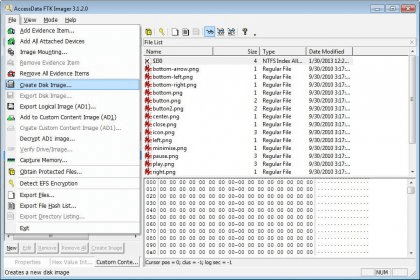
From a preservation perspective, this makes forensic imaging ideal an exact copy of the original data can be ingested into a secure and long-term storage environment. This creates an exact copy of the disk’s content at the bitstream level, thereby ensuring no loss of data during transfer. The Imaging Processīorrowing from techniques used in digital forensics, archivists at MARBL decided to capture forensic images of the disks from the Alice Walker collection.
Accessdata ftk imager limitations trial#
It was an experience that involved a great deal of careful trial and error, based on current best practices in the field of digital archives. The following article documents the various ways in which archivists at MARBL approached the Alice Walker disks, describing both the challenges and the successes. Useful guidelines and resources designed to help archivists transfer data from aging, often-obsolete media are available, but the idiosyncrasies of old disks often lead to unexpected obstacles. Transferring data off of such vulnerable media is, therefore, a key step towards its preservation. Alternatively, dust and dirt can contaminate and damage the surface of the disk, either destroying the data it contains or rendering it inaccessible. In the case of floppy disks, the magnetic media storing the data can demagnetize over time or be lost as a result of the increasing ineffectiveness of the adherent that holds it in place. Unfortunately, digital media left in this way is increasingly likely to suffer from bitrot and degradation. Ben Goldman, for example, worries that archives are facing a growing “‘disk-in-a-box’ problem” incoming born-digital materials stored in boxes, often indefinitely, for sheer lack of knowing what else to do with them. In the four years since OCLC published these findings, this number is likely to have increased.Īmongst members of the archival community, this has raised some questions about what is happening to born digital materials once they have entered collecting institutions. In a survey of special collection libraries conducted by OCLC in 2010, seventy-nine per cent of respondents reported having born digital materials among their collections.

Walker’s floppy disks joined a steadily growing collection of digital media and hardware already in MARBL’s collections, a trend in which MARBL is certainly not alone.

Labels on the disks provided some information about their content, indicating that they contained a mix of literary drafts, correspondence, speeches, and writings connected to Walker’s work as an activist around the world.

Amongst the collection were a number of born digital materials, including thirty-seven 3.5” floppy disks. In 2007, the Manuscript, Archives, and Rare Book Library (MARBL) at Emory University acquired the papers of writer and activist Alice Walker. Digital Archives literature has focused on imaging as a practical solution for the transfer of data from aging and often obsolete media, and this article documents attempts at MARBL to put these recommendations into practice. Early in this process, forensic images of the disks’ contents were captured and these bit-by-bit replicas of the data were stored as preservation copies.

Over the last year, archivists at Emory University’s Manuscript, Archives, and Rare Book Library (MARBL) processed thirty-seven 3.5” floppy disks included amongst the papers of writer and activist Alice Walker.


 0 kommentar(er)
0 kommentar(er)
